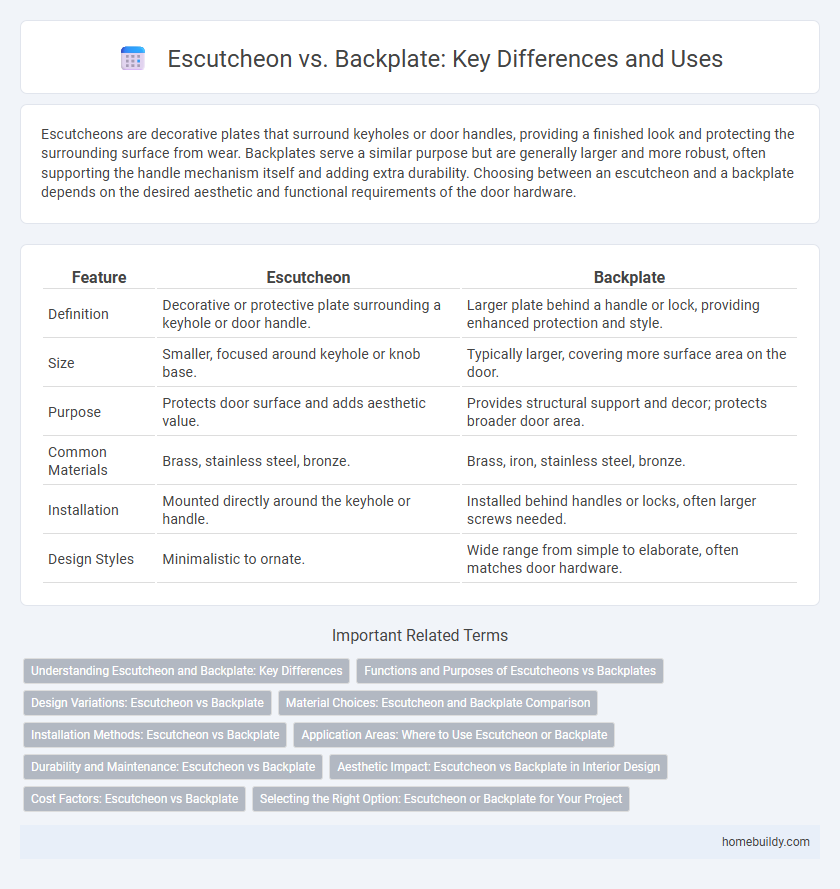Escutcheons are decorative plates that surround keyholes or door handles, providing a finished look and protecting the surrounding surface from wear. Backplates serve a similar purpose but are generally larger and more robust, often supporting the handle mechanism itself and adding extra durability. Choosing between an escutcheon and a backplate depends on the desired aesthetic and functional requirements of the door hardware.
Table of Comparison
| Feature | Escutcheon | Backplate |
|---|---|---|
| Definition | Decorative or protective plate surrounding a keyhole or door handle. | Larger plate behind a handle or lock, providing enhanced protection and style. |
| Size | Smaller, focused around keyhole or knob base. | Typically larger, covering more surface area on the door. |
| Purpose | Protects door surface and adds aesthetic value. | Provides structural support and decor; protects broader door area. |
| Common Materials | Brass, stainless steel, bronze. | Brass, iron, stainless steel, bronze. |
| Installation | Mounted directly around the keyhole or handle. | Installed behind handles or locks, often larger screws needed. |
| Design Styles | Minimalistic to ornate. | Wide range from simple to elaborate, often matches door hardware. |
Understanding Escutcheon and Backplate: Key Differences
An escutcheon is a protective or decorative plate surrounding a keyhole or door handle, typically smaller and focused on covering the keyhole area, while a backplate is a larger plate that supports and enhances the entire door handle or knob assembly. Escutcheons often provide added security by shielding the keyhole from tampering, whereas backplates contribute to both aesthetics and structural reinforcement. Understanding these distinctions helps in selecting hardware that balances security, style, and functional support for doors.
Functions and Purposes of Escutcheons vs Backplates
Escutcheons serve primarily as decorative and protective covers for keyholes or lock cylinders, preventing dust and tampering while enhancing aesthetic appeal. Backplates, larger than escutcheons, offer structural support by strengthening the door area around handles or locks, distributing force and reducing wear over time. Both elements improve door hardware functionality, but escutcheons focus on protection and style, whereas backplates emphasize durability and reinforcement.
Design Variations: Escutcheon vs Backplate
Escutcheons typically feature a minimalist design, focusing on a small, discreet plate that surrounds keyholes or door handles, emphasizing subtle decoration and functionality. Backplates offer a broader surface area that allows for more intricate and elaborate design variations, often incorporating ornamental patterns, raised motifs, and diverse shapes to enhance the overall aesthetic of doors and furniture. The design versatility of backplates makes them suitable for vintage, traditional, and eclectic styles, whereas escutcheons cater to modern and minimalist interior designs.
Material Choices: Escutcheon and Backplate Comparison
Escutcheons and backplates differ significantly in material options, with escutcheons commonly crafted from brass, stainless steel, or zinc alloy for enhanced corrosion resistance and durability. Backplates often feature heavier gauge metals like wrought iron or cast aluminum to provide additional structural support and aesthetic weight. Selecting between escutcheon and backplate materials depends on factors such as environmental exposure, desired finish, and functional requirements.
Installation Methods: Escutcheon vs Backplate
Escutcheons are typically installed by fitting them flush against the door surface and securing with concealed screws or adhesive, offering a sleek, minimalist appearance. Backplates require more extensive installation, often involving screw holes drilled into the door to accommodate the plate and the hardware mounted on it, providing additional structural support. The choice between escutcheon and backplate installation depends on the desired aesthetic and the need for reinforcement around keyholes or handles.
Application Areas: Where to Use Escutcheon or Backplate
Escutcheons are best suited for decorative or protective purposes around door locks and keyholes, enhancing aesthetic appeal while concealing irregularities on the door surface. Backplates offer greater functional support, often used with handles or levers to reinforce the hardware and distribute force over a larger area, making them ideal for high-traffic doors or heavy-use environments. Both are commonly applied in residential, commercial, and historical restoration projects, with escutcheons favored for elegance and backplates for durability.
Durability and Maintenance: Escutcheon vs Backplate
Escutcheons typically offer greater durability than backplates due to their solid metal construction, which resists wear and corrosion over time. Maintenance for escutcheons is minimal, requiring only occasional cleaning to maintain their finish, while backplates can accumulate dirt around the edges, demanding more frequent upkeep. The robust design of escutcheons ensures long-lasting protection for door hardware, minimizing the need for repairs or replacement.
Aesthetic Impact: Escutcheon vs Backplate in Interior Design
Escutcheons provide a sleek and minimalistic aesthetic, often integrating seamlessly with door hardware for a modern, understated look. Backplates offer a more substantial and decorative presence, serving as a design focal point that enhances traditional or ornate interiors. Choosing between escutcheons and backplates depends on the desired visual impact, with escutcheons emphasizing subtlety and backplates contributing texture and visual weight to the overall design.
Cost Factors: Escutcheon vs Backplate
Escutcheons typically have a lower cost compared to backplates due to their simpler design and smaller size, which reduces material and manufacturing expenses. Backplates often involve more intricate shapes and larger surfaces, leading to higher production costs and increased installation time. When budgeting for door hardware, selecting an escutcheon can offer a cost-effective solution without compromising basic protection and aesthetic appeal.
Selecting the Right Option: Escutcheon or Backplate for Your Project
Choosing between an escutcheon and a backplate depends on the specific functional and aesthetic needs of your project. Escutcheons, typically smaller and designed to cover keyholes or lock cylinders, offer a streamlined look ideal for modern or minimalist designs, while backplates provide a larger surface area to protect doors from wear and enhance decorative appeal, often suited for traditional or elaborate hardware. Evaluate factors such as door material, hardware compatibility, and desired visual impact to select the appropriate option that balances protection and style.
Escutcheon vs Backplate Infographic

 homebuildy.com
homebuildy.com